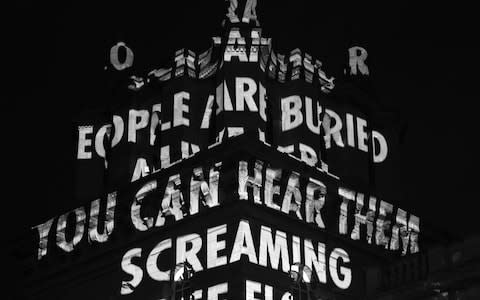Softer: Jenny Holzer at Blenheim Palace

Designed by Vanbrugh and set in spectacular grounds fashioned by Capability Brown, Blenheim Palace is the stateliest of Britain’s stately homes. A world heritage site, it is also the country’s only non-royal palace and the birthplace of Winston Churchill. But now, thanks to the American artist Jenny Holzer, it is impossible to overlook the rather less edifying fact that this monumental pile is also a spoil of war, given by Queen Anne to the first Duke of Marlborough as a reward for defeating the French at the Battle of Blenheim in 1704.
Holzer is known for using the power of words in unexpected places to uncover uncomfortable truths. Here, in what is possibly her most important exhibition to date, the world-renowned New York based artist uses an array of different materials and processes to reboot Blenheim’s military origins. Under the umbrella title of "SOFTER" she effectively transforms every part of the place into a war memorial, recalling both past battles as well as more recent conflicts and their still-reverberating consequences.

As dusk fell during the first 10 days of the exhibition, Blenheim’s ornate fa?ade was drenched in a spectacular tide of light projections. Titled "ON WAR", these texts covered the house - as well as an island in the lake - with haunting and often deeply disquieting first-hand accounts of the war in Iraq, from British war veterans and active military personnel as well as testimonies from those affected by the Syrian civil war. Sadly these proved too much of a production to run throughout the exhibition, but the piece lives on in a specially developed free app. When activated at any time of day - by pointing a phone inside specific parts of the palace - the app overlays any surfaces in its sights with versions of Holzer’s projected texts.
The projections may now be virtual, but the rest of Holzer’s interventions remain powerfully in situ throughout the palace. Suspended from the ceiling of the Great Hall, a four-sided LED sign dangles ominously, its surfaces incandescent with illuminated accounts of warfare and torture from Syrian refugees, as well as the poetry of Anna ?wirszczyńska, who wrote about her experiences in Warsaw during the Second World War.
The Polish poet’s words are also chiseled into marble benches positioned in and around the house. Carefully sourced to echo the lavish marbles and sandstone used in Blenheim’s interiors and facades, they blend elegantly with their surroundings until you read texts such as "YOU ENEMY WILL NOT KILL ME" meticulously chiseled into their surfaces.

Throughout the palace’s grand interiors, grim reminders of modern warfare repeatedly chime with the Palace’s bloody origins. On a large gilt-and-marble table in Blenheim’s opulent Saloon, a grisly array of neatly stacked human bones take the place formerly occupied by a 19th-century silver table ornament proudly depicting the First Duke writing his victory dispatch from the battlefield of Blenheim. Then in the Long Library a portrait bust of the victorious First Duke sits at the centre of a flower burst of curved LED signs, their multicoloured diodes unleashing torrents of testimonies collected from today’s soldiers.

For a number of years, Holzer has been making oil – and more recently watercolour - "redacted" paintings, which faithfully reproduce sometimes heavily censored declassified US military documents dating back to the beginnings of military initiatives in Afghanistan and Iraq. Many of these often almost abstract works are now propped in ceremonial rooms lined with the swagger portraits of the Marlborough dynasty.
Holzer did not know that her reworkings of official interrogation accounts and blunt lists of torture techniques with their deleted passages rendered in lurid reds and deep greens and blues, would blend in so harmoniously with Blenheim’s opulent décor, but the fact that they seem almost to be colour-coordinated with their surroundings renders them all the more disturbing.
Some interventions are deliberately sly. In one cabinet of precious porcelain, a human shoulder blade has been tucked in amongst the teacups, and arguably even more audacious is the coverlet embroidered with an account of a dying contemporary soldier draped on top of very bed in which Winston Churchill was born. (Let’s not forget Churchill’s central role in how much of the Middle East is still divided up today.)

Holzer is not an artist known for her playfulness but here she has also allowed herself – and us – a welcome touch of levity. In an unusually mischievous moment her special Blenheim app has also given the female, carved marble dragon- monster that lurks beneath the first Duke’s grandiose tomb in the chapel a new digital ease of life: when you walk into the library she flies around the room. Whether or not this unleashed lady-beastie refers to the time-honoured Marlborough family tradition of forbidding Duchesses to go on living in Blenheim after the demise of their Duke husbands, is not known.
SOFTER: Jenny Holzer at Blenheim Palace until 31 December 2017
